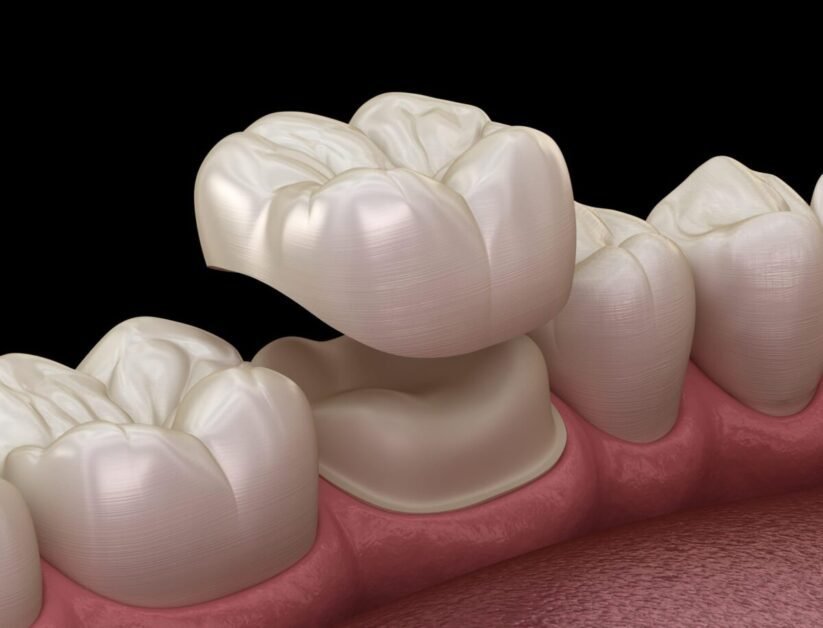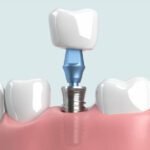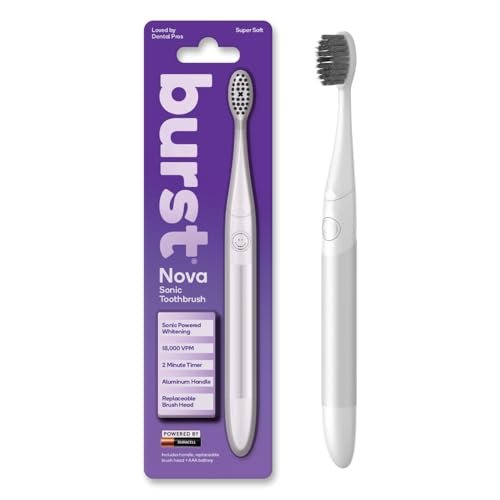Table of Contents
2. Common Causes of Tooth Damage: Identifying the Need for Dental Crowns
Tooth damage can occur for various reasons, often leading to the need for dental crowns. One common cause of tooth damage is tooth decay. When plaque and bacteria build up on the tooth surface, it can lead to the formation of cavities. If left untreated, these cavities can grow larger and compromise the structural integrity of the tooth. In such cases, a dental crown may be necessary to restore strength and function to the damaged tooth.
Another common cause of tooth damage is dental trauma. Accidents, falls, or sports injuries can result in chipped, cracked, or broken teeth. In more severe cases, the tooth may even be knocked out completely. Dental crowns can be a suitable treatment option for such cases, as they can provide protection and support to the damaged tooth, preventing further deterioration and potential tooth loss.
It is important to note that identifying the need for dental crowns requires a professional dental examination. Dentists are trained to assess the extent of tooth damage and recommend the most suitable treatment options, which may include dental crowns. Seeking prompt dental care when experiencing tooth damage is crucial in order to prevent further complications and preserve oral health.
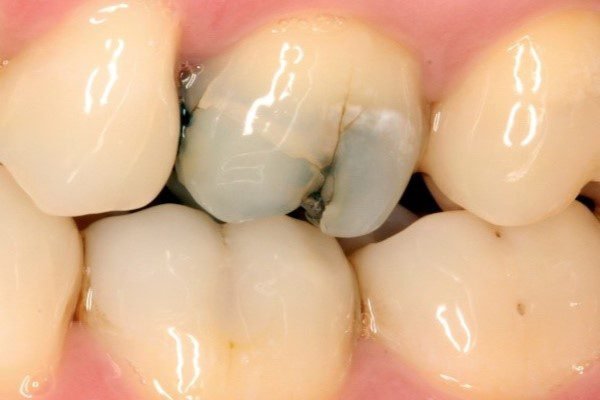
3. The Role of Dental Crowns in Restoring Function and Aesthetics
Dental crowns play a crucial role in restoring both the function and aesthetics of damaged teeth. When a tooth is significantly decayed, cracked, or weakened, a crown can provide the necessary support and protection to prevent further damage. Additionally, dental crowns can enhance the appearance of a tooth by improving its shape, size, and color.
Functionally, dental crowns act as a protective cap that covers the entire visible portion of a tooth. This not only strengthens the tooth but also restores its ability to withstand the forces of biting and chewing. With a crown in place, the tooth can regain its functionality, allowing individuals to comfortably and confidently eat a wide range of foods.
Aesthetically, dental crowns are custom-made to match the natural color, texture, and shape of the surrounding teeth. This ensures that the crown seamlessly blends in with the rest of the smile, resulting in a natural-looking appearance. Whether it is a front tooth or a molar, dental crowns offer an aesthetically pleasing solution to restore the overall harmony and beauty of the smile.
By restoring both the function and aesthetics of damaged teeth, dental crowns provide patients with a comprehensive solution to improve their oral health and enhance their smile. Whether it is due to decay, trauma, or wear and tear, dental crowns offer a reliable and long-lasting treatment option for those seeking to regain confidence in their smile.
4. Types of Dental Crowns: Exploring Your Options
When it comes to choosing a dental crown, patients have several options to consider. The most common types of dental crowns include porcelain-fused-to-metal (PFM), all-ceramic, metal, and zirconia.
Porcelain-fused-to-metal crowns are a popular choice as they provide a natural tooth-like appearance with the strength of a metal substructure. These crowns are durable and long-lasting, making them suitable for both front and back teeth. However, one drawback is that the metal substructure may cause a grayish line to appear near the gumline over time.
All-ceramic crowns, on the other hand, are known for their excellent aesthetics as they closely resemble the natural color and translucency of teeth. They are a great option for patients who prioritize a seamless, natural-looking smile. Additionally, all-ceramic crowns are metal-free, making them ideal for individuals with metal allergies. However, they may be less durable than PFM crowns and may not be suitable for patients with heavy bite forces or extensive tooth damage.
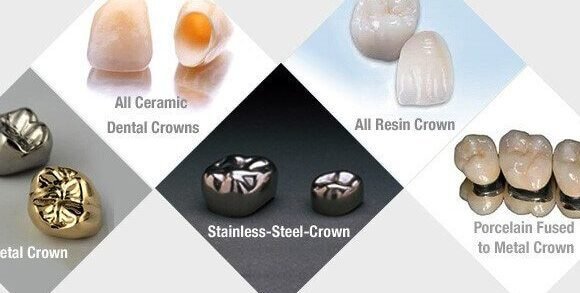
Metal crowns, typically made of gold or silver alloy, are known for their exceptional strength and longevity. These crowns are highly resistant to wear and tear, making them an excellent choice for molars and individuals prone to grinding or clenching their teeth. While metal crowns may not offer the natural appearance of other options, they are a reliable and functional choice for patients seeking durability above all else.
Lastly, zirconia crowns have gained popularity in recent years due to their remarkable strength and aesthetics. These crowns are made from a translucent material that closely mimics the appearance of natural teeth. Zirconia crowns are highly durable and resistant to chipping and cracking, making them an ideal choice for patients with severe tooth damage. They are also an excellent option for patients with metal allergies or those who require a restoration in a prominent area of their smile.
Overall, the choice of dental crown depends on various factors such as the location of the tooth, the desired aesthetic outcome, the patient’s oral health, and their personal preferences. It is recommended to consult with a dental professional to determine the most suitable type of crown for each individual case.
5. The Crown Placement Process: What to Expect
The crown placement process is a relatively straightforward procedure that involves several steps. First, your dentist will thoroughly examine your tooth and surrounding tissues to assess the extent of damage and to determine the appropriate treatment plan. This may involve taking X-rays or using other imaging techniques to get a clear picture of the tooth’s structure.
Next, your dentist will prepare the tooth by removing any decay or damage and shaping it to accommodate the dental crown. In some cases, the tooth may need to be built up with a filling material to provide a solid foundation for the crown. Your dentist will then take an impression of the prepared tooth, either using traditional putty or with the help of digital scanning technology.
The impression will be sent to a dental laboratory, where skilled technicians will fabricate the custom crown. While the crown is being created, your dentist may place a temporary crown on the prepared tooth to protect it and provide some aesthetics. Once the final crown is ready, usually within a couple of weeks, you will return to your dentist for the final placement.
During the placement appointment, your dentist will remove the temporary crown and carefully position the permanent crown on the prepared tooth. They will ensure a proper fit and bite, making any necessary adjustments to ensure a comfortable and natural feel. Once everything is satisfactory, the crown will be permanently cemented in place, restoring the function and appearance of your tooth.
It is important to note that the crown placement process is generally painless, as local anesthesia is used to numb the area during the procedure. Some patients may experience mild discomfort or sensitivity afterward, but it usually subsides within a few days. Your dentist will provide you with aftercare instructions and advise you on how to care for your new crown to ensure its longevity and maintain optimal oral health.
6. Factors to Consider When Choosing a Dental Crown Material
When it comes to choosing a dental crown material, there are several factors to consider. One of the main considerations is the location of the tooth that needs to be restored. For teeth at the back of the mouth, such as molars, a strong and durable material like metal or porcelain-fused-to-metal (PFM) may be recommended. These materials can withstand the forces of chewing and grinding that molars are subjected to. On the other hand, for front teeth that are more visible when you smile, a material that closely resembles the natural color and translucency of tooth enamel, such as all-ceramic or zirconia, may be preferable for a more aesthetic result.
Another important factor to consider is the cost of the dental crown material. Different materials have different price ranges, with metal crowns generally being more affordable compared to all-ceramic or zirconia crowns. However, it’s essential to remember that the cost should not be the sole determining factor, but rather a balance between the material’s durability, aesthetics, and affordability. Ultimately, consulting with your dentist will help you make an informed decision based on your specific needs and preferences.
| Factor | Description |
|---|---|
| Durability | How long the crown material is expected to last under normal chewing and biting forces. |
| Aesthetics | The ability of the material to match the color, texture, and translucency of natural teeth. |
| Biocompatibility | The crown material should be compatible with oral tissues and not cause adverse reactions. |
| Cost | The overall expense associated with the crown material, including initial cost and long-term maintenance. |
| Strength | The ability of the material to withstand biting and chewing forces without fracture or damage. |
| Tooth Preservation | The extent to which the preparation of the tooth for crown placement affects its natural structure. |
| Allergies/Sensitivities | Any known allergies or sensitivities the patient may have to certain crown materials. |
| Longevity | The expected lifespan of the crown material and its resistance to wear and degradation over time. |
| Clinical Suitability | Whether the material is appropriate for the specific clinical situation and functional requirements. |
| Ease of Placement/Repair | How easy it is for the dentist to place the crown initially and perform any necessary repairs or adjustments. |
7. Benefits of Dental Crowns: Beyond Restoring Damaged Teeth
Dental crowns are not only effective in restoring damaged teeth, but they also offer a range of benefits that go beyond simple restorations. One of the key advantages of dental crowns is their ability to provide structural support to weakened or compromised teeth. This added support helps to prevent further damage and potential tooth loss. By securely covering the tooth, dental crowns also enhance the tooth’s strength, allowing patients to comfortably chew and bite without any discomfort or concern.
In addition to their functional benefits, dental crowns can also greatly improve the appearance of damaged teeth. Crowns are custom-made to match the shape, size, and color of the patient’s natural teeth, resulting in a seamless and aesthetically pleasing smile. This can boost a patient’s confidence and self-esteem, as they no longer have to worry about visible tooth damage. Furthermore, dental crowns can help correct issues such as discoloration, misalignment, and gaps between teeth, giving patients a beautiful and harmonious smile.
| Benefit | Description |
|---|---|
| Strengthens Teeth | Dental crowns provide structural support to weakened or damaged teeth, preventing further deterioration and fracture. |
| Enhances Appearance | Crowns improve the appearance of teeth by covering discoloration, misshapenness, or other aesthetic imperfections, giving a natural and uniform look to the smile. |
| Restores Functionality | Crowns restore the functionality of teeth by enabling proper biting, chewing, and speaking, which may have been compromised due to decay, injury, or other dental issues. |
| Longevity | Well-maintained dental crowns can last for many years, offering a durable solution for tooth restoration compared to other options like fillings or bonding. |
| Protection | Crowns act as a protective barrier, shielding the underlying tooth from further damage, decay, or infection, thereby preserving oral health and integrity. |
| Versatility | They can be used in various dental procedures including dental implants, root canals, and dental bridges, providing versatile solutions for different dental needs. |
| Customization | Dental crowns are customizable in terms of color, shape, and size, allowing for a natural-looking restoration that blends seamlessly with the surrounding teeth. |
| Prevention of Shifting | Crowns help prevent adjacent and opposing teeth from shifting positions, maintaining proper dental alignment and occlusion, which is crucial for overall oral health. |
| Improved Confidence | By restoring the appearance and functionality of teeth, dental crowns can boost self-esteem and confidence, allowing individuals to smile, speak, and eat without hesitation. |
| Conservative Treatment Option | Compared to tooth extraction, crowns offer a conservative approach to dental care by preserving the natural tooth structure whenever possible, promoting long-term oral health. |
8. How Long Do Dental Crowns Last? Maintaining Longevity
Dental crowns are a common and effective solution for restoring damaged or decayed teeth, but how long can you expect them to last? The longevity of dental crowns can vary depending on several factors, including the type of crown used, the patient’s oral hygiene routine, and any habits or conditions that may put additional stress on the crown.
On average, dental crowns can last anywhere from 5 to 15 years or even longer. This wide range is due to the diverse materials used to create crowns, such as porcelain, metal, or a combination of both. For example, porcelain-fused-to-metal (PFM) crowns have been known to last for 10 to 15 years, while all-porcelain crowns may have a shorter lifespan of 5 to 10 years. Metal crowns, on the other hand, are highly durable and can last for several decades.
It’s important to note that proper oral hygiene practices play a crucial role in maintaining the longevity of dental crowns. Regular brushing and flossing, along with routine dental check-ups and cleanings, can help prevent gum disease and decay that could compromise the integrity of the crown. Additionally, avoiding habits like teeth grinding or clenching, biting on hard objects, or using teeth as tools can help reduce the risk of crown damage and prolong their lifespan.
In conclusion, while the lifespan of dental crowns can vary, proper maintenance and care can significantly contribute to their longevity. By choosing the right crown material, practicing good oral hygiene, and avoiding harmful habits, you can ensure that your dental crowns last as long as possible, allowing you to enjoy restored function and aesthetics in your smile.
9. Caring for Your Dental Crowns: Oral Hygiene Tips and Best Practices
Caring for your dental crowns is essential to maintain their longevity and the overall health of your oral cavity. Regular oral hygiene practices should be continued, such as brushing twice a day for two minutes each time and flossing daily to remove plaque and food particles. However, there are some best practices specifically tailored to ensure the proper care of your dental crowns.
Firstly, it is important to choose a toothbrush with soft bristles to avoid causing any damage to the crown. Brush gently and at a 45-degree angle to effectively clean around the crown and the gumline. It is recommended to use fluoride toothpaste to strengthen your natural teeth and prevent decay in the surrounding area. Additionally, incorporating an antimicrobial mouthwash into your routine can help maintain a healthy mouth by reducing bacteria.
In addition to regular oral hygiene practices, avoiding certain habits can help prolong the lifespan of your dental crowns. These include biting into hard or sticky foods, chewing on ice or other hard objects, and using your teeth as tools. These habits can put excessive pressure on the crowns and may lead to cracks or fractures.
By following these oral hygiene tips and best practices, you can ensure the longevity and functionality of your dental crowns, allowing you to enjoy a beautiful and healthy smile for years to come. Remember to consult your dentist if you have any concerns or questions regarding the care of your dental crowns.
10. Potential Risks and Complications Associated with Dental Crowns
Dental crowns are a widely used dental restoration method that can greatly improve the function and aesthetics of damaged teeth. While they are generally considered safe and effective, it is important to acknowledge that there are potential risks and complications associated with this procedure.
One potential risk is sensitivity. After the placement of a dental crown, some patients may experience temporary sensitivity to hot or cold foods and beverages. This sensitivity usually subsides within a few weeks, but it can be uncomfortable in the meantime. Additionally, there is a small risk of nerve damage during the crown preparation process, which may lead to prolonged sensitivity or other complications.
Another potential complication is crown fracture or dislodgement. Although dental crowns are designed to be durable, they can still be susceptible to damage. Factors such as teeth grinding, biting into hard objects, or a weak underlying tooth structure can increase the risk of crown fracture. In some cases, the crown may become loose or completely dislodged, requiring prompt dental intervention to repair or replace it.
It is important to note that these risks and complications associated with dental crowns are relatively rare. By working with a skilled and experienced dentist, following proper oral hygiene practices, and avoiding habits that can potentially damage the crown, patients can minimize their risk and enjoy the benefits of a restored smile.
11. Can Dental Crowns Fix All Types of Tooth Damage? Understanding Limitations
Dental crowns are a versatile and effective solution for repairing damaged teeth. However, it is important to understand their limitations and know when they may not be suitable for certain types of tooth damage. While dental crowns can address a wide range of dental issues, including decay, cracks, fractures, and discoloration, there are cases where alternative treatments may be more appropriate.
One limitation of dental crowns is when the damage extends to the root of the tooth or affects the surrounding gums. In such cases, root canal therapy or periodontal treatment may be necessary before a crown can be considered. Additionally, if a tooth has been severely weakened or there isn’t enough healthy tooth structure remaining, a dental crown may not provide sufficient support. In such situations, dental implants or bridges may be recommended as alternative treatment options. It is vital for dentists to carefully evaluate each patient’s specific case to determine the most suitable course of action.
12. Alternatives to Dental Crowns: When Are They Appropriate?
In some cases, dental crowns may not be the most suitable option for restoring damaged teeth. Alternatives to dental crowns can vary depending on the specific circumstances and the extent of tooth damage. One alternative that dentists may consider is dental bonding. Dental bonding involves applying a tooth-colored resin material to the damaged tooth and then shaping and polishing it to match the natural tooth appearance. This option is often used for minor cosmetic improvements or repairing small chips or cracks in the teeth.
Another alternative is dental veneers. Veneers are thin, custom-made shells that are bonded to the front surface of the teeth to improve their appearance. They can be used to correct a variety of dental issues, including chips, cracks, discoloration, and even minor misalignment. Veneers are a popular choice for patients seeking a long-lasting solution that can enhance the aesthetics of their teeth.
It’s important to note that the appropriateness of these alternatives to dental crowns will depend on the individual’s specific dental needs and the advice of the dentist. Consulting with a dental professional is crucial to determine the best course of treatment for each individual case.

13. The Cost of Dental Crowns: Factors to Consider
The cost of dental crowns can vary depending on several factors. One of the key factors to consider is the material used for the crown. There are various options available, including porcelain, metal, and porcelain-fused-to-metal (PFM). Each material has its own unique properties and benefits, which can influence the overall cost of the crown.
Another factor that can affect the cost is the complexity of the dental procedure. In some cases, additional treatments such as root canals or tooth extractions may be required before the crown can be placed. These additional procedures can add to the overall cost of the treatment.
It is important to note that the cost of dental crowns can also vary based on the location and the dental practice. Different regions and practices may have different pricing structures and fee schedules. Therefore, it is recommended to consult with your dentist and obtain a detailed cost estimate that is specific to your individual needs and circumstances.
14. Seeking Professional Advice: Consultation and Treatment Planning
When it comes to seeking professional advice for dental concerns, consultation and treatment planning play a crucial role. Consulting with a dentist allows individuals to discuss their oral health issues, gain a deeper understanding of potential treatment options, and develop a personalized treatment plan. During a consultation, dentists carefully evaluate the patient’s dental health, considering their unique needs and goals.
The consultation process often involves a thorough examination of the teeth and gums, including X-rays and other diagnostic tests. This comprehensive assessment helps the dentist identify any underlying dental issues and determine the appropriate treatment approach. Additionally, dentists may inquire about the patient’s medical history, lifestyle, and any concerns they have, ensuring a holistic approach to treatment planning. By engaging in open and honest communication during the consultation, the dentist and patient can work together to develop a treatment plan that is tailored to the individual’s specific requirements and preferences.
15. Dental Crown Success Stories: Real-Life Experiences
Dental crowns are a popular solution for restoring damaged teeth and improving both function and aesthetics. Many individuals have had successful experiences with dental crowns, finding them to be an effective and long-lasting solution. One patient, Sarah, had a cracked tooth that was causing her discomfort and affecting her confidence. After consulting with her dentist, she opted for a dental crown to repair the damage. Sarah was pleased with the results, as the crown not only restored the appearance of her tooth but also provided a strong and durable solution that allowed her to eat and speak comfortably.
Similarly, John, another patient, had a severely decayed tooth that required extensive restoration. His dentist recommended a dental crown to protect the remaining tooth structure and prevent further damage. After the crown placement procedure, John experienced a significant improvement in his oral health and regained full function of his tooth. He was particularly impressed with the natural appearance of the crown, which seamlessly blended with his surrounding teeth.
These success stories highlight the positive outcomes that can be achieved with dental crowns. Whether it’s repairing a cracked tooth or restoring a decayed tooth, dental crowns have proven to be a reliable and effective treatment option. Patients like Sarah and John can now enjoy restored dental function and a renewed sense of confidence in their smiles. So, if you’re considering dental crowns for your own dental concerns, consult with your dentist to determine if they are the right solution for you.
16. Dental Crown Aftercare: Ensuring Long-Term Oral Health
Dental crown aftercare is crucial to ensure the long-term oral health of patients who have undergone this procedure. After receiving a dental crown, it is important to maintain good oral hygiene practices and follow specific care instructions provided by your dentist.
First and foremost, regular brushing and flossing are essential to keep the crown and the surrounding teeth clean and free from plaque buildup. Use a soft-bristled toothbrush and a non-abrasive toothpaste to gently brush all surfaces of your teeth, including the crown. Don’t forget to pay special attention to the area where the crown meets your natural tooth. Additionally, flossing should be done daily to remove food particles and plaque from between the teeth and around the crown. Some patients find using a water flosser or interdental brushes to be helpful in maintaining oral hygiene with a dental crown.
Please note that this list
As you explore the various headings in this article, it’s important to note that this list is designed to guide you through the comprehensive topic of dental crown procedures. Each heading represents a specific aspect of dental crowns and provides valuable information to help you understand the process, benefits, and potential considerations involved. From identifying the common causes of tooth damage to exploring alternative treatment options, this article aims to provide a thorough examination of dental crowns and their role in restoring dental function and aesthetics.
With a focus on supporting your decision-making process, this article will delve into the factors to consider when choosing a dental crown material and highlight the potential risks and complications associated with the procedure. By addressing concerns such as longevity, oral hygiene, and cost, you’ll gain a holistic understanding of how to care for your dental crowns and maintain long-term oral health. Real-life success stories and aftercare tips will also be shared to offer additional insights and practical advice. Ultimately, this comprehensive guide aims to empower you with the information necessary to make informed decisions and achieve optimal dental well-being.
What are some common causes of tooth damage that may require dental crowns?
Common causes of tooth damage include tooth decay, fractures, cracks, trauma, and large fillings that weaken the tooth structure.
How do dental crowns restore both function and aesthetics?
Dental crowns provide a protective covering for damaged teeth, restoring their strength and function. Additionally, they are designed to match the color and shape of your natural teeth, enhancing the aesthetics of your smile.
What are the different types of dental crowns available?
There are several types of dental crowns, including porcelain-fused-to-metal (PFM), all-ceramic or all-porcelain, metal (gold or silver), and zirconia crowns. Each type has its own advantages and considerations.
What can I expect during the crown placement process?
The crown placement process typically involves multiple visits to the dentist. During the first visit, your tooth will be prepared, impressions will be taken, and a temporary crown will be placed. In the subsequent visits, the permanent crown will be fabricated and finally cemented onto your tooth.
What factors should I consider when choosing a dental crown material?
Factors to consider when choosing a dental crown material include durability, aesthetic appearance, cost, and any specific allergies or sensitivities you may have.
What are the benefits of dental crowns besides restoring damaged teeth?
In addition to restoring damaged teeth, dental crowns can improve the appearance of your smile, restore proper chewing and speaking abilities, prevent further tooth damage, and provide support to weakened teeth.
How long do dental crowns typically last?
The longevity of dental crowns depends on various factors, such as oral hygiene practices, regular dental check-ups, the material used, and the forces exerted on the crown. On average, dental crowns can last between 5 to 15 years.
How should I care for my dental crowns to ensure their longevity?
To maintain the longevity of dental crowns, it is important to practice good oral hygiene by brushing twice a day, flossing daily, avoiding excessive forces on the crowns (such as grinding or clenching), and visiting your dentist regularly for check-ups and cleanings.
Are there any potential risks or complications associated with dental crowns?
While dental crowns are generally safe, there can be potential risks or complications such as tooth sensitivity, allergic reactions to materials, gum irritation, or the need for additional dental work.
Can dental crowns fix all types of tooth damage?
Dental crowns are effective in fixing a wide range of tooth damage, including decay, fractures, cracks, and large fillings. However, they may not be suitable for all cases, such as extensive tooth loss or severe gum disease.
When are alternatives to dental crowns appropriate?
Alternatives to dental crowns, such as dental veneers or dental bonding, may be appropriate for cases where the tooth damage is minor or cosmetic in nature. It is best to consult with your dentist to determine the most suitable treatment option for your specific situation.
What factors should be considered when determining the cost of dental crowns?
The cost of dental crowns can vary based on factors such as the material used, the complexity of the case, the location of the dental practice, and any additional procedures required (such as root canal treatment). It is advisable to discuss the cost and insurance coverage with your dentist beforehand.
When should I seek professional advice regarding dental crowns?
It is recommended to seek professional advice regarding dental crowns if you have damaged teeth that may require restoration, if you are unsure about the treatment options available, or if you have any specific concerns or questions related to dental crowns.
Are there any real-life experiences or success stories related to dental crowns?
Yes, there are many success stories of individuals who have had dental crowns placed to restore their damaged teeth. These stories often highlight the positive impact that dental crowns have had on their oral health, function, and confidence.
How can I ensure long-term oral health after getting dental crowns?
To ensure long-term oral health after getting dental crowns, it is important to follow proper oral hygiene practices, maintain regular dental check-ups, avoid harmful habits like teeth grinding, and address any issues or concerns promptly with your dentist.

